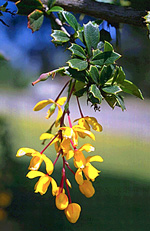 |
The Berberidaceae are an important family in temperate and subarctic latitudes of the Northern Hemisphere, represented in Australia by only one or two garden escapes or adventive shrubs occasionally found in the south-eastern States.
Characteristic features of the family Berberidaceae in Australia include: - shrubs with leathery, shining, prickly leaves and spiny shoots
- flowers yellowish or orange, in racemes, each more or less bell-shaped with several whorls of perianth parts
- ovary superior; fruit a bluish-black berry
Description
Evergreen shrubs. Stems unarmed or with thorns or spines arising from the leaf axils. Internal secretions of coloured sap. Plants glabrous or with simple, non-glandular hairs. Leaves alternate and spiral, petiolate, subsessile or sessile. Stipules absent or present, distinct and free from the petiole, scale-like or membranous or apparently spine-like, falling off early or persistent; stipellae absent. Lamina simple or once compound, imparipinnate, symmetric; lamina/leaflets lanceolate, ovate, oblanceolate, obovate or oblong; base cuneate, attenuate, rounded or oblique; margins dentate or spiny, ±flat, revolute or recurved; venation pinnate, with the midrib conspicuous, and the tertiary venation reticulate; surfaces not punctate; herbaceous or leathery. Plants with all the flowers bisexual. Inflorescences axillary, consisting of racemes or solitary flowers. Bracts present. Pollination by insects. Flowers stalked. Floral disc absent; nectaries present on the perianth. Perianth regular, of 2 dissimilar whorls, imbricate in bud. Calyx segments free, with 6 sepals, herbaceous. Corolla segments free, with 6–12 petals, alternating with or opposite the sepals, yellow or orange, without contrasting markings, membranous; lobes ±entire. Fertile stamens 6, alternating with the sepals, free of the corolla, free of the ovary and style, distinct from each other, all ±equal. Anthers basifixed, not versatile, opening outwards by valves; 2-celled. Ovary superior and sessile. Carpels 1 or 3, fused; ovary with 1 locule. Style absent and the stigma terminal and ±sessile on the ovary and usually 3-lobed. Ovules 1–5, sessile; placentation basal or parietal. Fruit a fleshy, indehiscent berry; the perianth on the maturing fruit deciduous. Disseminule micro-surface ±pruinose, red or blue, glossy or dull. Seeds 1–3 per fruit. Aril absent. Cotyledons 2. Embryo straight or round or shapeless.
(Note: this description has been generated from the coded data compiled for the key. Any errors in the key data will be reflected in the descriptions.)
A treatment of the family Berberidaceae has not yet been published in the Flora of Australia. It will appear in Volume 2.
Australian genera of Berberidaceae (as recognised for the Flora of Australia)
* = all species introduced
*Berberis
*Mahonia

|
  |

Berberis darwinii (flowers)
Photo: K.Thiele © ABRS

Mahonia leschenaultii (flowering branch)
Photo: anon © NSW National Herbarium
|

| |